Photo



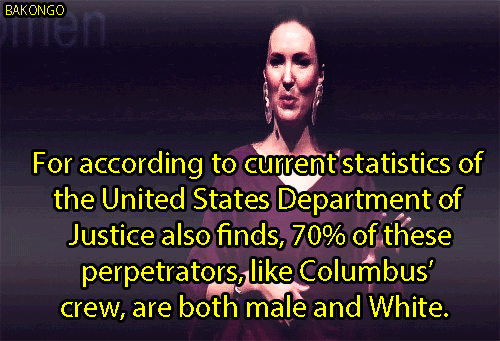
Violence Against Native Women is Not Traditional: Whisper at Ted x ABQWomen
44K notes
·
View notes
Photo


Young Diné for Diné Liberation
http://youtu.be/ycAbRNSu4-M
"Our generation chooses true sovereignty, and the protection of our air, land, and water. These things are not for sale and should not be corrupted. 150 years ago, our ancestors were exiled from Diné Bikéyah on the Long Walk. We honor the suffering and hardship they endured by maintaining our relationship with Nihímá Nahasdzáán and Yádilhiił, revitalizing K’é and our Diné lifeways. Today, the irresponsible decisions of the Navajo Nation government regarding energy colonization and exploitation threaten our homeland and the future of our people. Our message, Bidziil Beehaz’áanii Dinébi, is a message to the Diné people to say that we are strong and our voices do matter, regardless of how the Navajo Nation government ignores and undermines us. We must take it upon ourselves in this critical time to speak up and act to ensure a future for Diné people within our four sacred mountains.”
#riseup #empowerthepeople
Window Rock, AZ
80 notes
·
View notes
Photo
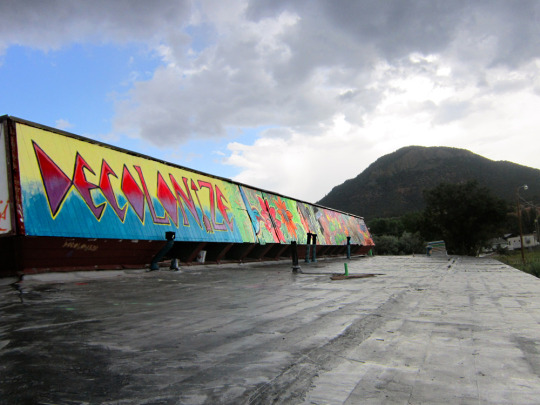
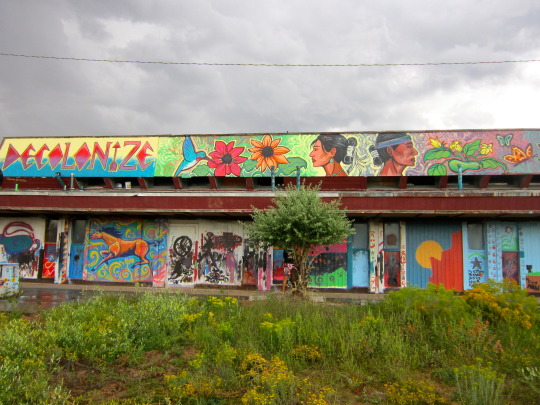
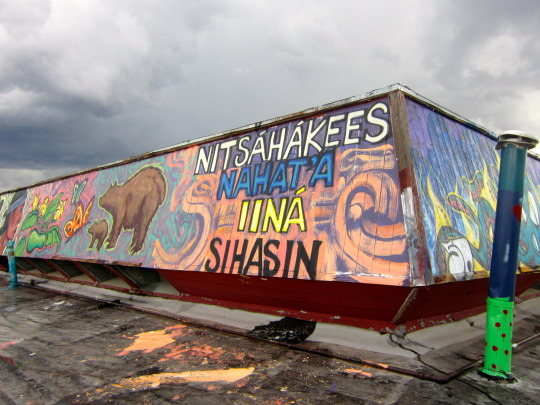
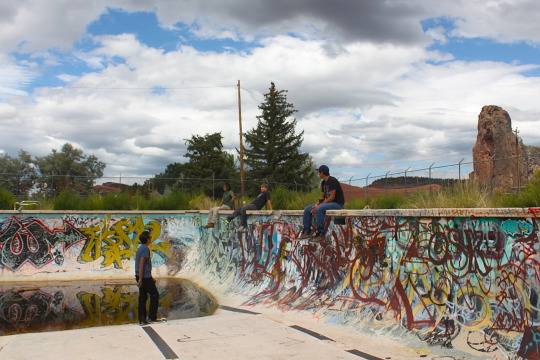
Spent a few days in the beautiful and remote community of Navajo, New Mexico. Navajo is a tiny place tucked between gigantic red rock formations and sits at the foot of Fuzzy Mountain, a sacred site where ecologically significant healing herbs and ceremonial plants are gathered. Navajo was once a booming milling town that harvested lumber from the nearby Chuska Mountains and used pristine ground water for their operations. The sawmills left behind a legacy of contaminated ground water and depleted Red Lake, along with a slew of abandoned buildings permeating with asbestos. It is here where The Fuzzy Mountain Mural Project sought to turn an abandoned recreation center into a community canvas. The large building, accompanied by an equally large pool became our island as we worked on the fiberglass roof and through daily thunderstorms.
The hummingbird represents perseverance and is a physical manifestation of a blessing. The couple in the middle is the Male and Female duality prevalent through out all aspects of Dine culture, it is the essence of life and our existence. They wear their hair in a bun (tsiyeel) showing pride in their Dine way of life. Accordingly, hair to us, as Dine, is a place for our knowledge and wisdom. To tie it in a tsiyeel means you are in control of your mind. The squash is food we grow for sustenance and the blossoms that we adorn ourselves with and the seeds of change we must plant in order to revitalize our traditional food systems as a means to assert food sovereignty, not only to counteract nutritionally related illnesses such as diabetes and obesity. The bear is sacred protector living in the Chuska Mountains and represents the need to protect our Dine way of life. The chief components of the traditional philosophy of Dine learning were included in the mural as a means to relate the Decolonization aspect to a central Dine belief. Nitsahakees is critical thinking and mental strength, it is the strategic integration of information through creativity. Nahat’a is a way of executing systematic and tactical planning that employs the development of skillful leadership. Iina is based on the quality of life by traditional Dine standards of living. Sihasin is self-awareness and assurance that life will continue if there is a sense of sensitivity regarding all living beings.
287 notes
·
View notes
Link
I had to see it for myself. Wanted to see what the worlds largest media conglomerate would do as it resurrected racist stereotype and let the most powerful hipster drive it forward for all for the masses to swallow pseudo-history in some celebrity worshipping blockbuster summertime backwards...
22 notes
·
View notes
Photo
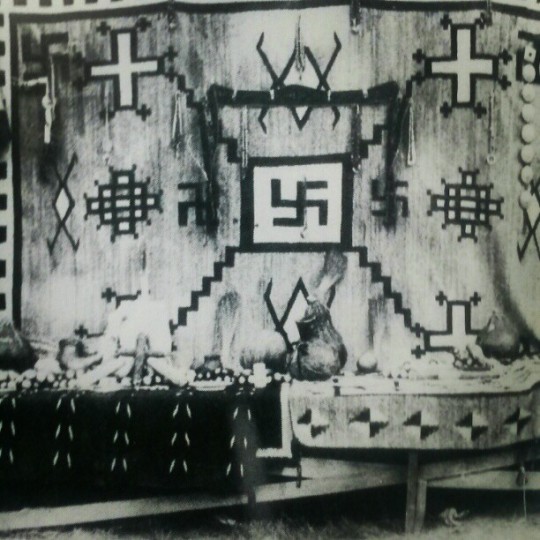
From “One Hundred Years of Navajo Rugs” by Marion Rodee. #navajo
145 notes
·
View notes
Photo
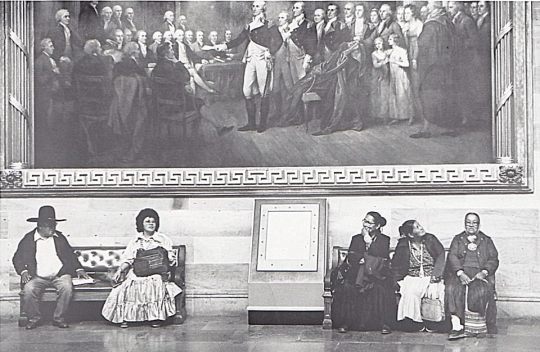
Photo from Jack Ahasteen (his mother is in the pic)
"The original Idle No More, lobbying against Diné relocation by U.S. Government in the 70's."
83 notes
·
View notes
Photo
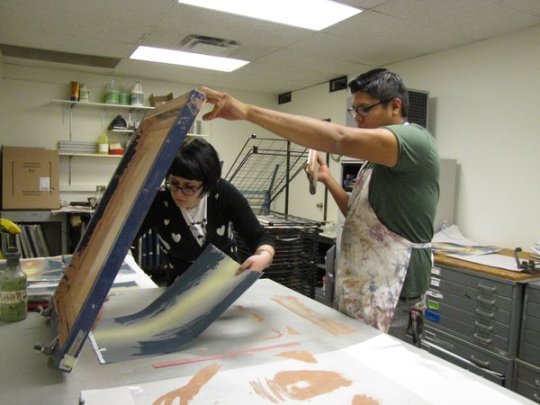


Check out my interview that aired on NPR
http://www.fronterasdesk.org/news/2013/jan/10/native-artist-profile-tom-greyeyes/
PHOENIX — Mixed media artist Tom Greyeyes chose to introduce himself for his interview with Fronteras Desk first in Navajo, and then in English.
“Hi, my name is Tom Greyeyes,” he said after the Navajo version. “I’m from Northern Arizona, I was born and raised in Flagstaff, Navajo Rez.”
He means he grew up between both places, Flagstaff at times, and the town of Tsegi, on the Navajo reservation, at other times. At 23, one of the topics he thinks a lot about is how Native young people of his generation straddle two worlds.
“A lot of us are sort of in this void, between traditional and then what I guess is American culture,” Greyeyes said. “And being in that void is sometimes frustrating. And there are always conflicting views, too, conflicting values.”
In a screenprint self portrait Greyeyes did in September, a man is grasping a root with his hands, as he is being lifted away.
Greyeyes’ tools of expression are diverse, ranging from wheatpastings to digital prints to spray paint.
He’s comfortable working on a large scale. He has paintings and graffiti installations that cover entire walls and appear on abandoned buildings on reservations. His whimsical sculptures of found objects stand out in barren landscapes.
Greyeyes said not all of his work is intended to be political. Some of it is abstract, and explores color and design. But within his art that makes a statement, Native identity and stereotypes seem to be among the reoccurring themes.
For the past week, he has been participating in a printmaking project with four other Native artists and graduate students at Arizona State University School of Art in the Herbergerer Institute, which will culminate in an exhibition and auction on Thursday night at the Night Gallery in Tempe. His print is a critique of Johnny Depp’s depiction of Tonto, the Lone Ranger’s Indian sidekick, in an upcoming Hollywood remake.
“It is about cultural appropriation,” Greyeyes said. “[Depp] is taking parts of Native culture and from what they originally meant and really distorting it.”
After graduating from Arizona State University’s art program last year, Greyeyes followed his girlfriend at the time to the San Carlos Apache reservation about 100 miles east of Phoenix.
“It is a very hard place to live, it is very different than my reservation,” said Greyeyes, who taught art while he was living there. “I started doing a lot of street art out there because there are a lot of abandoned, semi-burned down buildings.”
By Jude Joffe-Block
Proofs of the prints that Tom Greyeyes made this week. The subject is Johnny Depp’s portrayal of the character Tonto.
His outdoor works included a portrait of a young Native woman on a water tank and a grieving figure on the back of a deserted, blighted house.
One day he stumbled on an abandoned trailer and wanted to paint on it. He knocked on a house next door to ask permission, where he found a little girl and a woman.
“She was an older lady and she was like babysitting, and she was just drunk, it really stuck with me,” Greyeyes said. “I didn’t know how to react in a situation like that.”
It inspired his latest work, which he painted last week, and is now on exhibit at the Night Gallery. It is two-part painting that measures about 10 x 12 feet.
Greyeyes took this photo of his most recent painting, while it was in progress.
“The first image is a little girl, and she is sort of trapped in a 40 ounce bottle,” he said. “She is holding these little, little flowers.”
In part two, those little flowers have grown into a huge sunflower that has burst through the top of the bottle, leaving it broken. The little girl is gone.
“I am trying to insinuate that she escaped,” Greyeyes said.
The bottle represents alcohol abuse. The growing sunflowers – which grow wild on the San Carlos Apache reservation - stand for the persistence of tribal culture and values.
“Some communities, out there, especially on reservations, like the kids grow up sort of trapped in their family’s alcoholism,” Greyeyes said. “I hope they have a part of their culture, some sort of values they will kind of keep, and hopefully, it will grow and manifest into something, and get them out of situations like that when they are older.”
Losing his own cultural heritage is a theme that preoccupies Greyeyes.
“I’m very worried, my generation is very different than my dad’s generation, my parents generation,” Greyeyes said. “They are different than their grandparents, my grandparents. We are losing our traditional identity for sure.”
He says he has tried to find ways to connect to his heritage. He goes back to his family’s land and maintain a garden each summer. His brother raises horses in the way his father taught him. But he says it isn’t easy to find the right balance.
“I’ve tried to like reconnect a lot of times and sometimes I’ve failed, like horribly,” he said.
That sense of loss, though, may also be what inspires him to keep making art.
46 notes
·
View notes
Photo
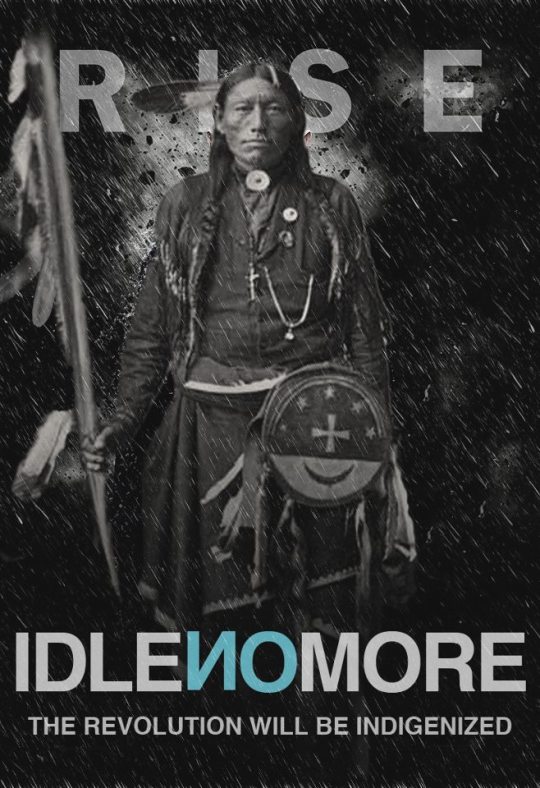
By Steven Paul Judd
478 notes
·
View notes
Photo
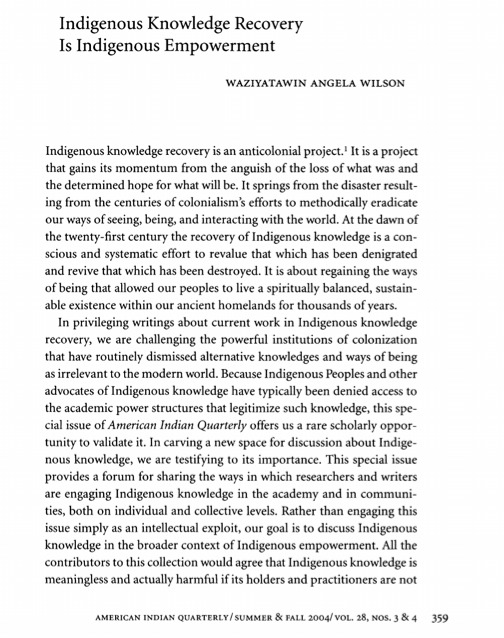
View and Download Full Article Here
188 notes
·
View notes
Video
Amazing students from the Santa Fe Indian School Spoken Word Team use their gifts to celebrate their identities as young Native peoples. This co-ed team of youths represent several different nations from Navajo to Tohono O’odham; Pueblos to Lakota and together, their voices give you chills, then make you laugh, then punch you in the stomach and ultimately-- remind you that they deserve to be heard. It is refreshing, powerful, and beautiful stuff.
Moccasins and Microphones is modern native storytelling, through performance poetry—a mix of dance, chant, beatbox, and some surprises.
31 notes
·
View notes
Quote
People of color have survived centuries of unspeakable violence against our cultures and our spirits. The cultures we have built today, in all their vibrancy and richness, are testaments to our strength and survival. Therefore, they have incredible meaning to us. When white folks just put them on like a pair of shoes, they neutralize years of resistance and celebration.
The day when all peoples have equal access to large-scale media, when all peoples can travel with the same freedom, when all peoples have equal and humanized representation in the global cultural landscape, THEN we can talk about cultural exchange and how cultures can benefit from influencing each other.
Until then, it’s just plain stealing.
I’m Sorry Whiteness, You Can’t have Everything (via thetart)
The most perfect cultural appropriation quote.
(via feministindianmanifesto)
10K notes
·
View notes
Photo

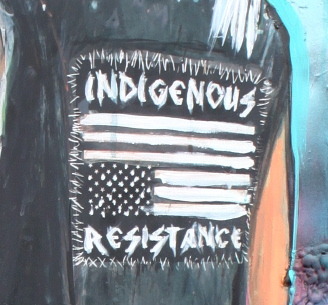
Indigenous Resistance - Punk Adszaa
4K notes
·
View notes
Photo
“I think the primary difference is that Indians experience and relate to a living universe, whereas Western people - especially scientists - reduce all things, living or not, to objects. The implications of this are immense. If you see the world around you as a collection of objects for you to manipulate and exploit, you will inevitably destroy the world while attempting to control it. Not only that, but by perceiving the world as lifeless, you rob yourself of the richness, beauty, and wisdom to be found by participating in its larger design.
In order to maintain the fiction that the world is dead -and that those who believe it to be alive have succumbed to primitive superstition - science must reject any interpretation of the natural world that implies sentience or an ability to communicate on the part of nonhumans. Science insists, at a great price in understanding, that the observer be as detached as possible from the event he or she is observing.
Contrast that with the attitude of indigenous people, who recognize that humans must participate in events, not isolate themselves.
Ironically, although science prides itself on being a search for knowledge, Indians can obtain knowledge from birds, animals, rivers, and mountains that is inaccessible to modern science. And Indians can use this knowledge to achieve better results. Take meteorology. Scientists know that seeding clouds with certain chemicals will bring rain, but this method of dealing with nature is wholly mechanical and forces nature to do our bidding. Indians achieved the same results more peacefully by conducting ceremonies and asking the spirits for rain. The two methods are diametrically opposed. It’s the difference between commanding a slave to do something and asking a friend for help.
Being attuned to their environment, Indians could find food, locate trails, protect themselves from inclement weather, and anticipate coming events thanks to theirunderstanding of how all things are related. This knowledge isn’t unique to American Indians. It’s available to anyone who lives primarily in the natural world, is reasonably intelligent, and respects other life-forms for their intelligence. Respect for other life-forms filters into our every action, as does its opposite: perceiving the world as lifeless. If you objectify other living things, then you are committing yourself to a totally materialistic universe - which is not even consistent with the findings of modern physics.
The central idea of science, as it has been developed and applied, is to get machines or nature to do the work human beings don’t want to do. This is immensely practical, but in a shortsighted way.”
— Vine Deloria, Jr.

74 notes
·
View notes
Video
youtube
Issues facing Navajo elders seeking voting IDs.
(via Just How Hard Is It for a Navajo Elder to Get Voter ID? [VIDEO] | The Nation)
14 notes
·
View notes
Link
Here is a list of just some of the books I have read thus far related to Native and Indigenous studies. They vary from fiction to non-fiction, from ethnographic research to prophecies and instructions, and from poetry to academic writing. Included at the end is also a list of books I have only...
144 notes
·
View notes
Video
vimeo
Senate Bill 2109 Seeks to Extinguish Navajo and Hopi Water Rights
SB 2109 was introduced into congress on February 14, 2012
Over 300 Diné and Hopi people ( including traditional people and elders) upset by the latest colonial attack on indigenous peoples water rights, gathered to protest the visits of two US Senators (Jon Kyl & John McCain) to the Navajo Nation April 5, 2012.The people had gathered to say "NO DEAL" and "KILL THE BILL" to S2109, the bill that would allow for more water to flow into Arizona for the benefit of companies and urban growth.
Protesters chanted "Water Is Life", "Free Indian Water Ends Now", "Let the Water Flow", "Sewage Water for McCain and Kyl", other chants were said in Diné.
Protesters waited for the Navajo president Ben Shelly and US senators McCain and Kyl to exit the meeting in Tuba City, on the Navajo Nation. Earlier protesters marched in the streets of Tuba City, as Navajo Nation President Ben Shelly met with the Senators to discuss the further dismantling of Navajo and Hopi water rights. Navajo Nation president Ben Shelly announced to the public after the meeting that a deal has not been made yet. He stated that "the agreement will have to be agreed to by the Navajo People." There are 7 town hall meetings scheduled to hear input from 7 of the 110 chapter houses (similar to districts) and council delegates. However, the Navajo people would like more than 7 town hall meetings because this bill affects more chapters including ones in New Mexico.
FOR FURTHER INFO VISIT THESE SITES:
From the frontlines of the water wars: Diné and Hopi water rights at risk, protesters gather on Navajo Nation
A Difficult Choice on Water
Black Mesa Water Coalition
"They want people to give up their claim to a clean water source, then they want to deregulate pollution standards. It's a slow methodical form of manslaughter by toxicity."
SIGN THE PETITION TO REMOVE S.2109 FROM CONSIDERATION
34 notes
·
View notes


